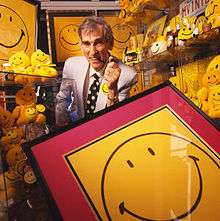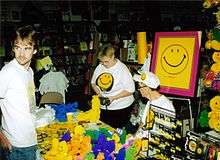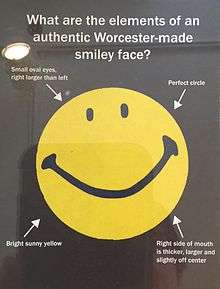Harvey Ball

Harvey Ross Ball (July 10, 1921 – April 12, 2001) was an American commercial artist. He is recognized as the earliest known designer of the smiley, which became an enduring and notable international icon.[1] Ball was born and raised in Worcester, Massachusetts. During his time as a student at Worcester South High School, he became an apprentice to a local sign painter, and later attended Worcester Art Museum School, where he studied fine arts.
Harvey Ross Ball's military service
Ball was based in Asia and the Pacific during World War II and was awarded the Bronze Star for heroism during the Battle of Okinawa. He served 27 years in the National Guard, retired as a Brigadier General in 1973 and then served six years in the Army Reserves. He retired as a full colonel in 1979. Ball was awarded the Veteran of the Year award from the Worcester Veterans Council in 1999.
State Mutual and the birth of the smiley

After World War II, Ball worked for a local advertising firm until he started his own business, Harvey Ball Advertising, in 1959. He designed the smiley in 1963.
The State Mutual Life Assurance Company of Worcester, Massachusetts (now known as Hanover Insurance) had purchased Guarantee Mutual Company of Ohio. The merger resulted in low employee morale. In an attempt to solve this, Ball was employed in 1963 as a freelance artist, to come up with an image to increase morale. What he created was a smiley face, with one eye bigger than the other. In less than ten minutes, Harvey Ball came up with the simple yet world-changing smiley face. The simplicity of the image brought smiles to the faces of the executives, who paid him $45 for his creation.[2]
The use of the smiley face became part of the company's friendship campaign whereby State Mutual handed out 100 smiley pins to employees. The aim was to get employees to smile while using the phone and doing other tasks. The buttons became popular, with orders being taken in lots of 10,000. More than 50 million smiley face buttons had been sold by 1971, and the smiley has been described as an international icon.
Ball never applied for a trademark or copyright of the smiley and earned just $45 for his work (US $315 in 2010 inflation-adjusted dollars). State Mutual, similarly, did not make any money from the design. Ball's son, Charles, is reported to have said his father never regretted not registering the copyright. Telegram & Gazette reported Charles Ball as saying "he was not a money-driven guy, he used to say, 'Hey, I can only eat one steak at a time, drive one car at a time.'"
From Smiley to Icon

The phrase "Have a happy day" became associated with the Smiley although it was not part of Ball's original design. Philadelphian brothers Bernard and Murray Spain designed and sold products with the phrase and logo in the early 1970s. They trademarked the combination and later changed the phrase to "Have a nice day", which itself has become a phrase in everyday use in North America
The Smiley was introduced to France in 1972 as a signal of a good news story in the newspaper France Soir. Frenchman Franklin Loufrani used the image this way and made swift moves to trademark the image. His company now turns over $100 million a year and became embroiled in a copyright dispute with Walmart over the image in the 1990s.[3]
The BBC broadcast a radio documentary on 4 February 2012 called Smiley's People that covered the story of the smiley.[4] This is currently available for playback.
Promotion
On July 18, 1998, around the 35th anniversary of the design's inception, Ball appeared at That's Entertainment to meet fans and sign smiley pins and art. At this appearance Ball was shown copies of the graphic novel Watchmen issue #1, which featured a notorious image of a smiley face with a splatter of blood across it.[5] Store Manager Ken Carson was quoted as saying Ball seemed amused to see it on the cover.[6]
Distinguishing features of smiley face

An authentic Harvey Ball smiley face can always be identified by three distinguishing features: Narrow oval eyes, with the right one larger than the left, bright sunny yellow, and a slightly off center mouth, which has been attributed to being similar to a "Mona Lisa Mouth".[7]
World Smile Foundation
The World Smile Corporation was founded by Ball in 1999. The Corporation licenses Smileys and organizes World Smile Day. World Smile Day raises money for the Harvey Ball World Smile Foundation, a non-profit charitable trust that supports children's causes. World Smile Day is held on the first Friday of October each year and is a day dedicated to "good cheer and good works". The catch phrase for the day is "Do an act of kindness - help one person smile".
Posthumous
Ball died on April 12, 2001, aged 79, as a result of liver failure following a short illness.
The land that was owned by the Ball Family, off Granite Street in Worcester, was purchased by the City of Worcester in June 2007, with help from Mass Audubon and a $500,000 grant from the state Executive Office of Environmental Affairs' Division of Conservation Services. This property links Mass Audubon's Broad Meadow Brook Sanctuary with the developing Blackstone River Bikeway. It is now known as the "Harvey Ball Conservation Area" and is home to the appropriately named "Smiley Face Trail."
References
- ↑ Honan, William H. (2001-04-14). "H. R. Ball, 79, Ad Executive Credited With Smiley Face". The New York Times. p. C6.
- ↑ Doug Lennox , illustrated by Catriona Wight (2004), Now You Know More: The Book of Answers, Now You Know, 2 (illustrated ed.), Dundurn, p. 50, ISBN 9781550025309
- ↑ http://www.bbc.co.uk/programmes/b01bh91h
- ↑ http://www.bbc.co.uk/programmes/b01bh91h
- ↑ Watchmen, DC, 1986 series, entry in the Grand Comics Database, includes picture of cover with the smiley
- ↑ Craig S. Semon (March 6, 2009), "Smiley face connection", Worcester Telegram
- ↑ "Who Really Invented the Smiley Face?". Smithsonian Magazine. March 13, 2013. Retrieved May 17, 2016.